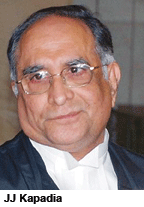Chief Justice S.H. Kapadia & Justice Swatanter Kumar
 “The word ‘free’ in the long title to the 2009 Act stands for the removal by the State of any financial barrier that prevents a child from completing eight years of schooling (para 5).
“The word ‘free’ in the long title to the 2009 Act stands for the removal by the State of any financial barrier that prevents a child from completing eight years of schooling (para 5).Advancement of education is a recognised head of charity. S.3(2) has been enacted with the object of removing financial barriers which prevents a child from accessing education (para 7).
The State is also expected to first weed out those schools which are non-performing, or under-performing, or non-compliance schools (p.8).
Under the said Article (21A), the obligation is on the State to provide free and compulsory education to all children of specified age. However, under the said Article the manner in which the said obligation will be discharged by the State has been left to the State to determine by law  (p.9).
(p.9).
 (p.9).
(p.9).A child who is denied the right to access education is not only deprived of his right to live with dignity, he is also deprived of his right of freedom of speech and expression enshrined in Article 19(1). The 2009 Act seeks to remove all those barriers which a child belonging to the weaker sections and disadvantaged groups has to face while seeking admission (p.10).
In this case we are concerned with the interplay of Article 21, Article 21A on the one hand and the right to establish and administer educational institutions under Article 19(1) (g) read with Article 19(6). That was not an issue in T.M.A Pai Foundation nor in P.A. Inamdar (p.11).
Justice K.S. Radhakrishnan
 “Further it was ordered (by the T.M.A Pai Foundation judgement) that the expression ‘education’ in all the Articles of the Constitution would mean and include education at all levels, from primary education level to postgraduate level and the expression ‘educational institutions’ would mean institutions that impart education as understood in the Constitution (para 21).
“Further it was ordered (by the T.M.A Pai Foundation judgement) that the expression ‘education’ in all the Articles of the Constitution would mean and include education at all levels, from primary education level to postgraduate level and the expression ‘educational institutions’ would mean institutions that impart education as understood in the Constitution (para 21).Casting burden on other students to pay for the education of others was also disapproved by the Pai Foundation (judgement), holding there should be no subsidy (p. 22).
Pai Foundation (judgement) was pronounced on 31.10. 2002 (and) 25.11.2002. Article 21A, new Article 45 and Article 51A(k) were inserted into the Constitution on 12.12.2002 … Parliament it may be noted, was presumed to be aware of the judgement in Pai Foundation, and no obligation was cast on unaided private institutions but only on the State, while inserting Article 21A (p.25).
Inamdar (judgement) held that to admit students being one of the components of the right to establish and administer an institution, the State cannot interfere therewith and upto the level of undergraduate admission, minority unaided educational institutions enjoy “total freedom” (p.29).
We have to give due respect to the 11 judges in Pai Foundation and the seven judges judgement in Inamdar. The principles laid down in those judgements still hold good and are not whittled down by Article 21A… (p.83).
The State however, cannot free itself from obligations under Article 21A by offloading or outsourcing its obligation to private non-State actors like unaided private educational institutions or coerce them to act on the State’s dictate (p.96)
Article 21A has used the expression “the State shall provide” and not “provide for”. Hence the constitutional obligation to provide education is on the State and not on non-state actors. The expression is clear and unambiguous (p.101).
Article 21 read with 21A, therefore casts an obligation on the State and State alone (p.103).
(Excerpts from the majority and dissenting judgements Society for Unaided Schools of Rajasthan vs. Union of India & Anr (Writ petition (C) No. 95 of 2010)



























